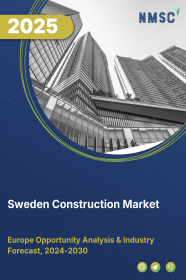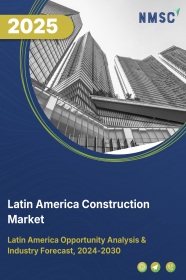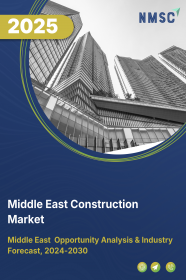
Sweden Construction Market by Type (Renovation, and New Construction), by Sector (Real Estate and Others), by Construction Method (Traditional Construction, Prefabricated/Modular Construction, 3D Printed Construction, Green/Sustainable Construction), and by Type of Contractor (Large Contractor, Medium Contractor and Small Contractor) – Country Industry Trends and Forecast, 2025–2030
Industry: Construction & Manufacturing | Publish Date: 26-Sep-2025 | No of Pages: 87 | No. of Tables: 117 | No. of Figures: 62 | Format: PDF | Report Code : CM2206
Sweden Construction Industry Overview
The Sweden Construction Market size was valued at USD 49.30 billion in 2024, and is projected to grow to USD 56.54 billion by 2025. Additionally, the industry is expected to continue its growth trajectory, reaching USD 77.80 billion by 2030, with a CAGR of 6.6% from 2025 to 2030.
Sweden construction market is experiencing strong growth, primarily fueled by government-backed infrastructure projects aimed at enhancing the country's railway and transportation systems.
The launch of a national infrastructure investment plan and major rail initiatives are reinforcing sustainable mobility and regional connectivity. This sector’s substantial contribution to Sweden’s GDP reflects its central role in the nation's economic development.
However, the market faces notable challenges from complex regulatory frameworks that slow project execution and inflate costs. Amid these hurdles, the increasing adoption of digital tools such as Building Information Modeling (BIM), along with AI, IoT, and cloud integration, is creating new opportunities for improved collaboration, efficiency, and digital transformation across construction activities.
Large-Scale Infrastructure Projects Driving Market Growth
Sweden’s construction market is expanding steadily due to significant investments in national infrastructure. Key developments, such as the Stockholm subway extension and the Uppsala light rail, highlight the government's commitment to improving connectivity and urban mobility. These projects are not only enhancing transport networks but also creating strong demand across the construction value chain.
Rising Adoption of Green and Sustainable Construction
Sweden’s focus on sustainability is accelerating the shift toward green construction. The adoption of energy-efficient designs, eco-friendly materials, and projects like Stockholm Wood City reflect a national push for low-carbon development. This transition is further supported by regulatory incentives and Sweden’s broader climate goals, making sustainability a central driver of construction activity.
Regulatory and Permitting Delays Hampering Market Growth
Regulatory hurdles remain a major challenge in Sweden’s construction market. Delays in permitting—exacerbated recently by disruptions in digital services used by municipalities—have significantly slowed project approvals. The need to navigate complex zoning laws, environmental assessments, and multi-level government approvals not only prolongs timelines but also raises costs. These inefficiencies risk deterring investment and delaying critical infrastructure development.
Integration of Digitalization and BIM Presents Lucrative Opportunity for Market Expansion
Sweden's construction industry is embracing digital transformation, with Building Information Modeling (BIM) becoming a standard practice. The Swedish Transport Administration mandates BIM for all new infrastructure projects, enhancing efficiency and collaboration across the sector. This digital shift is further supported by initiatives like the Smart Built Environment program, aiming to reduce construction costs and time by 33% by 2030 through digitalization and industrial processes. The widespread adoption of BIM and other digital tools presents significant opportunities for market growth and innovation in Sweden's construction sector.
Competitive Landscape
The key players operating in the Sweden construction industry include Skanska AB, NCC AB, Peab AB, JM AB, Veidekke ASA, Erlandsson Bygg AB, AF Gruppen ASA, Svevia AB, Hedin Construction AB, BDX Företagen AB, Implenia AG, Jan Frohlund Construction Company AB, Wästbygg Gruppen AB, MVB AB, EGH-Bygg, and others.
Sweden Construction Market Key Segments
By Type
-
Renovation
-
New Construction
By Sector
-
Real Estate
-
Residential
-
Affordable
-
Luxury
-
-
Commercial
-
Retail Buildings
-
Office Buildings
-
Hospitality
-
Healthcare Facilities
-
Educational Institutes
-
Entertainment Ventures
-
-
- Infrastructure
-
Transportation
-
Airport
-
Port
-
Rail
-
Road
-
-
Water and Wastewater
-
Energy
-
Telecommunication
-
- Industrial
-
Manufacturing Plant
-
Warehouses
-
Power Plants
-
Oil Refineries
-
Chemical Plants
-
By Construction Method
-
Traditional Construction
-
Prefabricated/Modular Construction
-
3D Printed Construction
-
Green/Sustainable Construction
By Type of Contractor
-
Large Contractor
-
Medium Contractor
-
Small Contractor
Key Players
-
Skanska AB
-
NCC AB
-
Peab AB
-
JM AB
-
Veidekke ASA
-
Erlandsson Bygg AB
-
AF Gruppen ASA
-
Svevia AB
-
Hedin Construction AB
-
BDX Företagen AB
-
Implenia AG
-
Jan Frohlund Construction Company AB
-
Wästbygg Gruppen AB
-
MVB AB
-
EGH-Bygg
Report Scope and Segmentation
|
Parameters |
Details |
|
Market Size in 2024 |
USD 49.30 Billion |
|
Revenue Forecast in 2030 |
USD 77.80 Billion |
|
Growth Rate |
CAGR of 6.6% from 2025 to 2030 |
|
Analysis Period |
2024–2030 |
|
Base Year Considered |
2024 |
|
Forecast Period |
2025–2030 |
|
Market Size Estimation |
Billion (USD) |
|
Growth Factors |
|
|
Companies Profiled |
15 |
|
Market Share |
Available for 10 companies |
|
Customization Scope |
Free customization (equivalent up to 80 working hours of analysts) after purchase. Addition or alteration to country, regional, and segment scope. |
|
Pricing and Purchase Options |
Avail customized purchase options to meet your exact research needs. |

















 Speak to Our Analyst
Speak to Our Analyst

























